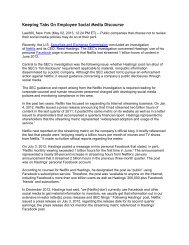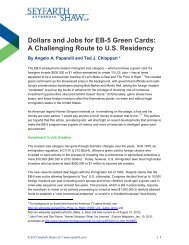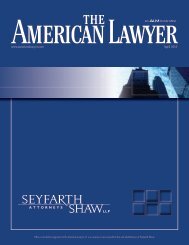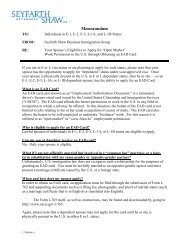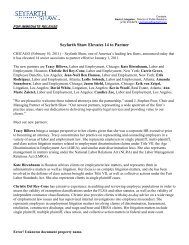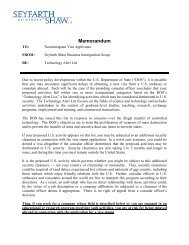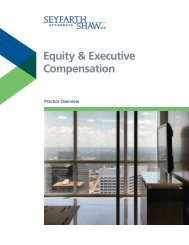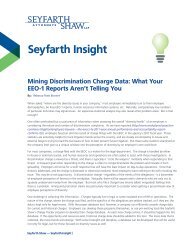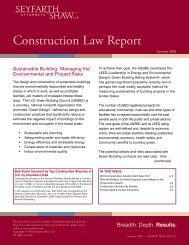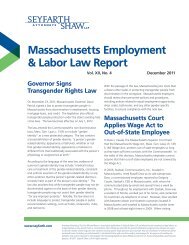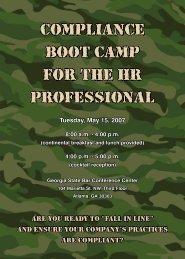Litigating California Wage & Hour and Labor Code Class Actions
Litigating California Wage & Hour and Labor Code Class Actions
Litigating California Wage & Hour and Labor Code Class Actions
You also want an ePaper? Increase the reach of your titles
YUMPU automatically turns print PDFs into web optimized ePapers that Google loves.
expectations <strong>and</strong> the realistic requirements of the job, shall be considered in<br />
determining whether the employee satisfies this requirement. 361<br />
Given <strong>California</strong>’s complete rejection of any form of qualitative test for exempt status, it<br />
would be possible for one manager to spend only 45 percent of his or her time performing<br />
exempt tasks (or closely <strong>and</strong> directly related tasks), <strong>and</strong> for another manager in the same<br />
position to spend 55 percent. The first manager would not be exempt, while the second<br />
manager would be exempt. In Nordquist v. McGraw-Hill Broadcasting Co., 362 this is<br />
precisely what happened: the court of appeal refused to rely on another court’s ruling that<br />
the plaintiff’s own successor was exempt because the inquiry was too “fact specific.” While<br />
Nordquist was not a class action, its reasoning seemed inconsistent with the notion that<br />
exempt misclassification cases would be good c<strong>and</strong>idates for class litigation.<br />
In light of the various pronouncements about the individualized inquiry necessary to<br />
determine an employee’s exempt status, the defense bar was hopeful that courts would<br />
disapprove of a plaintiff obtaining class certification on the ground that a class of managers<br />
was uniformly misclassified as exempt. If an employer could bring forth some declarations<br />
from managers attesting that they spend more than half their time on exempt tasks, the<br />
best a plaintiff could argue was that many managers at other stores spent the majority of<br />
their time on non-exempt tasks. In any case, the finder of fact would need to examine each<br />
store <strong>and</strong> each manager individually to determine if the managers there were misclassified<br />
as exempt—an inquiry inconsistent with class litigation.<br />
Employers were disappointed when the <strong>California</strong> Supreme Court issued Sav-On Drug<br />
Stores, Inc. v. Superior Court, 363 which indicated that exempt misclassification cases may<br />
often be appropriate for certification. In Sav-On, the trial court certified a class of store<br />
managers notwithst<strong>and</strong>ing evidence that exempt status of individual managers varied<br />
from store manager to store manager based on differences in how they divided their time<br />
between exempt <strong>and</strong> non-exempt tasks. The court of appeal held that individualized issues<br />
necessarily predominated over common issues because the fact finder would need to<br />
examine each store manager’s work habits to see whether that manager spent the majority<br />
of his or her time on exempt tasks.<br />
In reversing, the <strong>California</strong> Supreme Court emphasized that the appellate court had given<br />
insufficient deference to the trial court’s determination that common issues predominated.<br />
The court clarified that if a reasonable person might conclude from the record that common<br />
issues predominated over individualized ones, then a trial court’s certification order should<br />
361<br />
362<br />
363<br />
See, e.g., <strong>Wage</strong> Order 7-2001 § 2(K).<br />
32 Cal. App. 4th 555, 569 (1995).<br />
34 Cal. 4th 319 (2004).<br />
Seyfarth Shaw LLP | www.seyfarth.com <strong>Litigating</strong> <strong>California</strong> <strong>Wage</strong> & <strong>Hour</strong> <strong>Class</strong> <strong>Actions</strong> (12th Edition) 77



